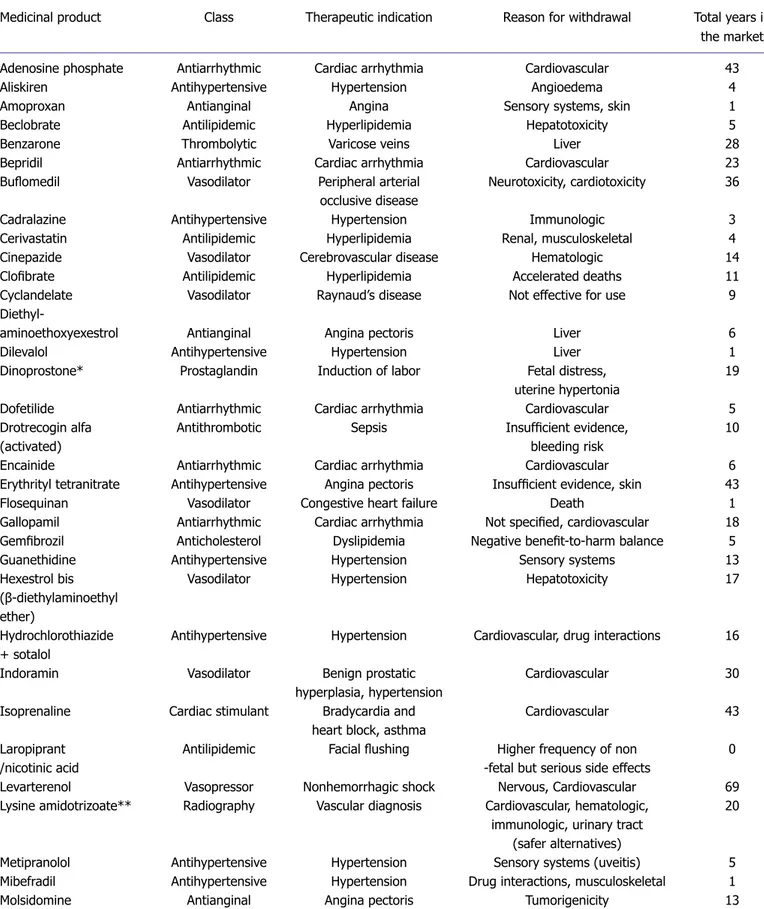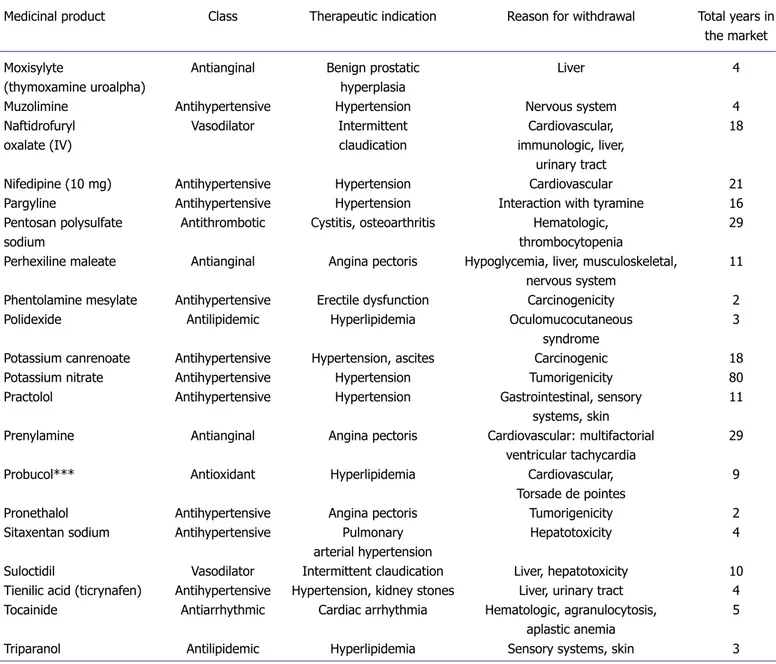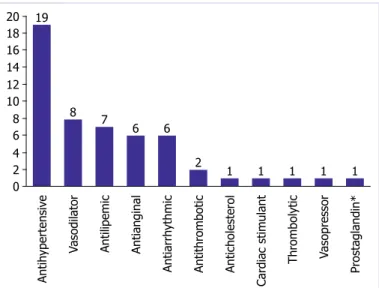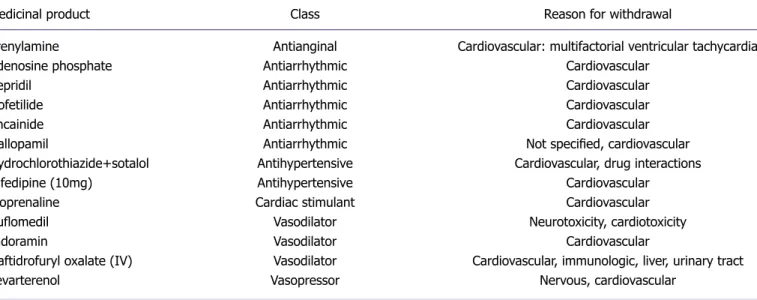Kumsal Kocadal,1 Sahan Saygi,1 Fehmi Burak Alkas,1 Semra Sardas2
1Department of Toxicology, Near East University Faculty of Pharmacy, Nicosia, TRNC
2Department of Toxicology, Istinye University Faculty of Pharmacy, Istanbul, Turkey
ABSTRACT
A considerable number of drugs were withdrawn from the world market in the last decades due to safety reasons. A retro-spective review of withdrawals is important in determining the adequacy of regulations regarding the safety and efficacy of drugs. The scope of the present study was to focus on cardiovascular adverse reactions of 61 withdrawn medicinal products, as well as 40 additional drugs withdrawn due to non-cardiovascular toxicity, while being cardiovascular agents themselves. A detailed web-based data search was held to draw a list of withdrawn pharmaceutical products from the pharmaceutical market by regulatory authorities between 1950 and 2017 due to safety reasons. A total of 464 medicinal products were withdrawn from the pharmaceutical markets between 1950 and 2017 due to safety reasons. Hepatotoxicity was the most commonly reported adverse drug reaction (ADR) that led to withdrawal, followed by immune-related reactions, neurotoxicity, and cardiovascular toxicity. The underlying mechanisms leading to cardiovascular toxicity should be investigated in depth to avoid the use of risky drugs for long periods, especially in consideration of the fact that some cardiovascular drugs persisted in the market for many decades. Furthermore, improved reporting of suspected adverse reactions and stricter regulations will lead to quicker detection of ADRs, thus emphasizing the importance of this public health problem and highlighting the need for improved “early warning systems” to manage the risks of high-risk drugs.
Keywords: Cardiovascular toxicity; drug safety; drug withdrawal.
Received: February 02, 2018 Accepted:April 07, 2018 Online: September 05, 2018
Correspondence: Dr. Sahan SAYGI. Yakin Dogu Universitesi Eczacilik Fakultesi, Toksikoloji Anabilim Dalı, Yakin Dogu Bulvari, Pk: 99138 / 99138 Lefkosa, K.K.T.C.
Tel: +90 392 223 64 64 - 5108 e-mail: sahan.saygi@neu.edu.tr
© Copyright 2019 by Istanbul Provincial Directorate of Health - Available online at www.northclinist.com
North Clin Istanb
doi: 10.14744/nci.2018.44977
Drug-associated cardiovascular risks: A retrospective
evaluation of withdrawn drugs
A
newly designed drug passes through a long and tough route before reaching the market, and throughout its way, the safety, efficacy, and quality are the most compellable issues. Although the drugs are tested very elaborately for their safety in addition to their effi-cacy during preclinical and clinical trials, some concerns, such as difficulties in extrapolating drug data from an-imal to man, sample size that is required to emphasize to assess clinical benefit, limited duration in relatively healthy adults, and detection of rare adverse drug reac-tions (ADRs) and drug interacreac-tions, remain as problems to overcome. During preclinical and clinical studies, as well as post-marketing surveillance, the drug mustsat-isfy all safety and efficacy concerns to launch and remain in the pharmaceutical market. These concerns are ad-dressed by the system of pharmacovigilance, the part-ners of which are health authorities, hospitals, academia, healthcare professionals, pharmaceutical industry, and patients. A meta-analysis published by Lazarou et al. [1] reported that ADRs are responsible for >100,000 deaths and 2 million hospital admissions, making them between the fourth and sixth most common causes of death. This prevalence of ADR-related problems also revealed the requirement for national pharmacovigilance systems in the last decades. Although the pharmacovigilance data collected in developed countries initially appeared
ap-Cite this article as: Kocadal K, Saygi S, Alkas FB, Sardas S. Drug-associated cardiovascular risks: A retrospective evaluation of withdrawn
drugs. North Clin Istanb 2019;6(2):196–202.
propriate for extrapolation to other countries, the role of many confounding factors, primarily cultural and genetic predisposition, has proven the fallacy of this practice.
Therefore, the World Health Organization (WHO) recommends every country to establish their own phar-macovigilance systems and become full members of the WHO Programme for International Drug Monitoring. As of September 2017, this program has 127 partici-pating member countries, and further 29 countries are associate members whose national pharmacovigilance centers are under establishment [2].
Despite the establishment of the Turkish regulatory system in 1985 and membership in the WHO Pro-gramme for International Drug Monitoring since 1987, effective oversight and monitoring commenced in 2005 with the establishment of the Turkish Pharmacovigi-lance Centre (TUFAM), which became responsible for detecting post-marketing drug safety problems [3].
In the present study, particular emphasis was placed on cardiovascular ADRs due to many concerns; be-cause of being among the potentially life-threatening conditions and, due to their wide prevalence, being the fourth reason for withdrawal (n=61), after hepatotoxic-ity (n=81), immune-related reactions (n=79), and neu-rotoxicity (n=76). Moreover, the treatment options for negative cardiovascular effects are either lifelong or cured with major surgery, which both impart a severe medical, psychological, and economic burden on the patient, as well as additional costs on the healthcare system [4, 5].
The objective of the present study was to evaluate drugs withdrawn due to their cardiovascular risks, as well as cardiovascular drugs that were removed from the pharmaceutical market due to adverse effects either re-lated or unrere-lated to their own pharmacological action worldwide between the period of 1950 and 2017.
Methods
In the present study, detailed web-based data search and concurrent systematic reviews that summarize all removed drugs worldwide have been conducted [4, 6, 7]. Taking the above statement into account, our review updates and evaluates the data on drugs related to the cardiovascular system. The reputable sources given be-low compile a list of withdrawn cardiovascular drugs and drugs withdrawn for their cardiovascular concerns: • WHO’s Drug Information (volumes 1–30)
• The WHO’s Pharmaceutical Newsletters (1997–2017)
• The UK Medicine and Healthcare Products Regula-tory Agency website
• The UK Medicine and Healthcare Products Regula-tory Agency, Drug Safety Monthly Updates ( January 2015–May 2017)
• The US Food and Drug Administration (FDA) website • PubMed
• Records of Turkish Medicines and Medical Devices Agency
• European Medicines Agency (EMA) website.
Veterinary medicines and drugs removed due to com-mercial reasons by pharmaceutical companies were not included in our data.
Results
A total of 464 drugs were withdrawn from 88 different pharmacological classes by 2017 according to our recent research. Of the 464 withdrawn drugs, 53 had cardio-vascular indications (Table 1). There were 11 different pharmacological classes, namely antihypertensives, va-sodilators, antilipidemics, antianginals, antiarrhythmics, antithrombotics, anticholesterol agents, cardiac stimu-lants, thrombolytics, vasopressors, and prostaglandins as shown in Figure 1.
In addition, a total of 61 medicinal products from 33 different pharmacological classes were subject to with-drawal due to cardiovascular adverse effects. Those most likely to cause cardiovascular toxicity were psychostim-ulants (n=8), analgesics (n=5), antiarrhythmics (n=5), antipsychotics (n=4), and vasodilators (n=3), with the remaining 36 drugs distributed among 28 classes as shown in Figure 2. There were 13 drugs that were both cardiovascular agents and were withdrawn due to cardio-vascular toxicity as shown in Table 2.
Discussion
The benefits provided by a medication might come with associated risks to health and well-being. Benefits must outweigh risks by a significant margin in all cases. The ideal medication should combine a high benefit–risk ra-tio, optimal treatment with the least number of medica-tions, and affordable cost of treatment.
It is noteworthy that some of the withdrawn drugs remained in the market for long periods. For instance, potassium nitrate despite its tumorigenic effects remained as an antihypertensive agent in the market for 80 years.
Medicinal product Class Therapeutic indication Reason for withdrawal Total years in
the market
Adenosine phosphate Antiarrhythmic Cardiac arrhythmia Cardiovascular 43
Aliskiren Antihypertensive Hypertension Angioedema 4
Amoproxan Antianginal Angina Sensory systems, skin 1
Beclobrate Antilipidemic Hyperlipidemia Hepatotoxicity 5
Benzarone Thrombolytic Varicose veins Liver 28
Bepridil Antiarrhythmic Cardiac arrhythmia Cardiovascular 23
Buflomedil Vasodilator Peripheral arterial Neurotoxicity, cardiotoxicity 36
occlusive disease
Cadralazine Antihypertensive Hypertension Immunologic 3
Cerivastatin Antilipidemic Hyperlipidemia Renal, musculoskeletal 4
Cinepazide Vasodilator Cerebrovascular disease Hematologic 14
Clofibrate Antilipidemic Hyperlipidemia Accelerated deaths 11
Cyclandelate Vasodilator Raynaud’s disease Not effective for use 9
Diethyl-
aminoethoxyexestrol Antianginal Angina pectoris Liver 6
Dilevalol Antihypertensive Hypertension Liver 1
Dinoprostone* Prostaglandin Induction of labor Fetal distress, 19
uterine hypertonia
Dofetilide Antiarrhythmic Cardiac arrhythmia Cardiovascular 5
Drotrecogin alfa Antithrombotic Sepsis Insufficient evidence, 10
(activated) bleeding risk
Encainide Antiarrhythmic Cardiac arrhythmia Cardiovascular 6
Erythrityl tetranitrate Antihypertensive Angina pectoris Insufficient evidence, skin 43
Flosequinan Vasodilator Congestive heart failure Death 1
Gallopamil Antiarrhythmic Cardiac arrhythmia Not specified, cardiovascular 18
Gemfibrozil Anticholesterol Dyslipidemia Negative benefit-to-harm balance 5
Guanethidine Antihypertensive Hypertension Sensory systems 13
Hexestrol bis Vasodilator Hypertension Hepatotoxicity 17
(β-diethylaminoethyl ether)
Hydrochlorothiazide Antihypertensive Hypertension Cardiovascular, drug interactions 16
+ sotalol
Indoramin Vasodilator Benign prostatic Cardiovascular 30
hyperplasia, hypertension
Isoprenaline Cardiac stimulant Bradycardia and Cardiovascular 43
heart block, asthma
Laropiprant Antilipidemic Facial flushing Higher frequency of non 0
/nicotinic acid -fetal but serious side effects
Levarterenol Vasopressor Nonhemorrhagic shock Nervous, Cardiovascular 69
Lysine amidotrizoate** Radiography Vascular diagnosis Cardiovascular, hematologic, 20
immunologic, urinary tract (safer alternatives)
Metipranolol Antihypertensive Hypertension Sensory systems (uveitis) 5
Mibefradil Antihypertensive Hypertension Drug interactions, musculoskeletal 1
Molsidomine Antianginal Angina pectoris Tumorigenicity 13
In contrast, synthetic Coumarin (anticoagulant) and Laropiprant/nicotinic acid (antilipidemic) were both withdrawn within a year of their launch, which is a testa-ment to the improvetesta-ments in the ADR reporting mech-anisms and the awareness and acceptance of the pharma-covigilance systems worldwide. In Turkey, withdrawals were done at the same time as the EMA or FDA with-drawals, except sibutramine, which was withdrawn in Turkey due to the efforts of the TUFAM a month ahead
of the EMA and 8 months ahead of the FDA [8]. At least 200 ADR reports are expected to be sub-mitted per million individuals annually according to the WHO [9]. ADR reports to the FDA between 2006 and 2014 have shown a 2.7-fold increase in the United States [10]. These high rates of ADRs and the withdrawal of products even that had appeared as “good drugs” in the market for many years cause loss of confidence to both drugs and the health authorities [6]. In the present study,
Medicinal product Class Therapeutic indication Reason for withdrawal Total years in
the market
Moxisylyte Antianginal Benign prostatic Liver 4
(thymoxamine uroalpha) hyperplasia
Muzolimine Antihypertensive Hypertension Nervous system 4
Naftidrofuryl Vasodilator Intermittent Cardiovascular, 18
oxalate (IV) claudication immunologic, liver,
urinary tract
Nifedipine (10 mg) Antihypertensive Hypertension Cardiovascular 21
Pargyline Antihypertensive Hypertension Interaction with tyramine 16
Pentosan polysulfate Antithrombotic Cystitis, osteoarthritis Hematologic, 29
sodium thrombocytopenia
Perhexiline maleate Antianginal Angina pectoris Hypoglycemia, liver, musculoskeletal, 11
nervous system
Phentolamine mesylate Antihypertensive Erectile dysfunction Carcinogenicity 2
Polidexide Antilipidemic Hyperlipidemia Oculomucocutaneous 3
syndrome
Potassium canrenoate Antihypertensive Hypertension, ascites Carcinogenic 18
Potassium nitrate Antihypertensive Hypertension Tumorigenicity 80
Practolol Antihypertensive Hypertension Gastrointestinal, sensory 11
systems, skin
Prenylamine Antianginal Angina pectoris Cardiovascular: multifactorial 29
ventricular tachycardia
Probucol*** Antioxidant Hyperlipidemia Cardiovascular, 9
Torsade de pointes
Pronethalol Antihypertensive Angina pectoris Tumorigenicity 2
Sitaxentan sodium Antihypertensive Pulmonary Hepatotoxicity 4
arterial hypertension
Suloctidil Vasodilator Intermittent claudication Liver, hepatotoxicity 10
Tienilic acid (ticrynafen) Antihypertensive Hypertension, kidney stones Liver, urinary tract 4
Tocainide Antiarrhythmic Cardiac arrhythmia Hematologic, agranulocytosis, 5
aplastic anemia
Triparanol Antilipidemic Hyperlipidemia Sensory systems, skin 3
*Dinoprostone is a prostaglandin that has a direct mechanism of action as a vasodilator; **Lysine amidotrizoate is a radiographic agent but it is used for vascular diag-nosis; ***Probucol is an antioxidant that acts as an anti-hyperlipidemic drug.
most drugs were conventional drugs. On the other hand, the number of biotechnological drugs is increasing as both original products and biosimilar products due to the expiration of biopharmaceutical patents. The num-ber of ADRs on VigiBase Data has exceeded 12 million by 2015 [7, 11, 12], thus warranting increased awareness of pharmacovigilance.
Similarly, the EudraVigilance system, established by the EMA, systematically works to encourage reporting of potential ADRs in Europe. In response to systematic works, the number of submitted reports showed an in-creasing trend, and the number of reports submitted to the
EudraVigilance system exceeded 1 million in 2015 [13]. National centers, such as TUFAM, also play a signif-icant role in increasing public awareness of drug safety. The legal time limit of submitting traced ADR reports to the TUFAM is restricted to 15 days. The annual num-ber of ADR report submissions to the TUFAM follows an increasing trend between 2006 and 2013, with the number of reports increasing by 8.2 times during this interval. However, the elevation of the number of ADR reports (2600 reports in 2013) is not high enough to reach the point expected from a population of 75 million according to a study [14]. Therefore, extensive collabora-tion between all partners of the pharmacovigilance sys-tem is necessary to ensure that a sufficient level of ADR reporting is achieved after marketing [3].
There are multiple intrinsic and extrinsic factors that can determine the patient’s response to any pharmaceu-tical agent. A meta-analysis by Hakkarainen et al. [15] suggested that 45%–52% of ADRs are preventable. One significant intrinsic factor is the genetic make-up of the patient. The emerging field of pharmacogenomics can greatly facilitate the tailoring of a patient-specific dose regimen and aid in the reduction of ADRs occurring as the genetic make-up of each person is unique. He et al. [16] showed a correlation between a functional poly-morphism in the CYP3A4 gene and an increased risk of coronary heart disease in the study population.
The main target of both pharmacogenomics and phar-macovigilance is to understand the heterogeneity and the structure of the drug efficacy and safety distribution signals
Figure 1. Cardiovascular classes of withdrawn drugs.
20 19 8 7 6 6 2 1 1 1 1 1 18 16 14 12 10 8 6 4 2 0 Antih ypertensiv e
Vasodilator Antilipemic Antianginal
Antiarrh ythmic Anti thr ombotic Anticholester ol Car diac stimulant Thr ombolytic Vasopr essor Pr ostaglandin*
Figure 2. Pharmacological classes of drugs withdrawn in response to their cardiovascular toxicity.
9 8 5 5 4 3 2 2 2 2 2 2 2 2 1 1 1 1 1 1 1 1 1 1 1 1 1 1 1 1 1 1 1 1 8 7 6 5 4 3 2 1 0 Psy chostimulant Antiarrh ythmic Analgesic Antipsy chotic Vasodilator Antihistamine Antiparkinsonian Anesthetic Propulsiv e Antih ypertensiv e Radiogr aph y Antidepr essant
Antispasmodic Antidyspepsia Antilactation
Pr okinetic agent Anti tussiv e Hematinic Antihelminth Emetic Antimicr obial Car diac Stimulant Antidote Vasopr essor Antiepileptic Nasal decongestant Br onchodilator Muscle r elaxant Antianginal Antio xidant Sympathomimetic Hypogly cemic Nootr opic
among the population. Although these two disciplines are synergistic conceptually and practically, these disciplines do not have a sensible convergence up to now [17].
The current implementation of pre-licensing Phase III trials involves the participation of 500–10,000 in-dividuals, followed by the full licensing of the drug for the market. Post-marketing studies, which succeed the launch of the drug, are optional under the current regime. In light of the pharmacovigilance concept, it has become necessary that drugs undergoing Phase III trials with at least 3000 individuals should only obtain a conditional approval, followed by compulsory post-marketing stud-ies involving at least 30,000 individuals by taking ADR reports into consideration for newly discovered drug molecules, only after which the full license should be is-sued. Building on these considerations, health problems caused by ADRs can be highly mitigated [18, 19].
Conclusion
In light of the above information, the existing drug safety procedures should be widely reconsidered. In conclusion, collaboration between the participants of the pharma-covigilance system is necessary to develop and maintain an effective system for detecting post-marketing safety risks to protect public health.
Conflict of Interest: The authors declare that they have no conflict of interest.
Financial Disclosure: The authors declare that they have received no financial support.
Authorship contributions: Concept – SSar.; Design – KK; Super-vision – SS; SSar.; Materials – KK; FBA; Data collection and/or pro-cessing – KK; SS; FBA; Analysis and/or interpretation – KK, SSar.; Literature search – KK; SS; FBA; SSar.; Writing – KK; SS; FBA; SSar.; Critical review – SS; SSar.
REFERENCES
1. Lazarou J, Pomeranz BH, Corey PN. Incidence of adverse drug reac-tions in hospitalized patients: a meta-analysis of prospective studies. JAMA 1998;279:1200–5. [CrossRef ]
2. UMC - Members. Available at: https://www.who-umc.org/global-pharmacovigilance/members/. Accessed May 27, 2017.
3. Uppsala: the Uppsala Monitoring Center - Uppsala Reports October 2005. 1st ed. p. 5. Available at: https://www.who-umc.org. Accessed
May 2, 2019.
4. Onakpoya IJ, Heneghan CJ, Aronson JK. Post-marketing withdrawal of 462 medicinal products because of adverse drug reactions: a system-atic review of the world literature. BMC Med 2016;14:10. [CrossRef ]
5. Sultana J, Cutroneo P, Trifirò G. Clinical and economic burden of ad-verse drug reactions. J Pharmacol Pharmacother 2013;4:S73–7. 6. Giacomini KM, Krauss RM, Roden DM, Eichelbaum M, Hayden MR,
Nakamura Y. When good drugs go bad. Nature 2007;446:975–7. 7. Singh JA, Wells GA, Christensen R, Tanjong Ghogomu E, Maxwell
L, Macdonald JK, et al. Adverse effects of biologics: a network meta-analysis and Cochrane overview. Cochrane Database Syst Rev 2011:CD008794. [CrossRef ]
8. TC Sağlık Bakanlığı. Pepper Time Kapsül (Biber hapı) hakkında, Sağlık Bakanlığı İlaç ve Eczacılık Genel Müdürlüğü (05.08.2010 ve B.10.0.İEG.0.11.00.01-330.06 sayılı yazı).
9. WHO. Safety Monitoring of Medicinal Products: Guidelines for Set-ting Up and Running a Pharmacovigilance Centre: 5. Special Issues In
Medicinal product Class Reason for withdrawal
Prenylamine Antianginal Cardiovascular: multifactorial ventricular tachycardia
Adenosine phosphate Antiarrhythmic Cardiovascular
Bepridil Antiarrhythmic Cardiovascular Dofetilide Antiarrhythmic Cardiovascular Encainide Antiarrhythmic Cardiovascular
Gallopamil Antiarrhythmic Not specified, cardiovascular
Hydrochlorothiazide+sotalol Antihypertensive Cardiovascular, drug interactions
Nifedipine (10mg) Antihypertensive Cardiovascular
Isoprenaline Cardiac stimulant Cardiovascular
Buflomedil Vasodilator Neurotoxicity, cardiotoxicity
Indoramin Vasodilator Cardiovascular
Naftidrofuryl oxalate (IV) Vasodilator Cardiovascular, immunologic, liver, urinary tract
Levarterenol Vasopressor Nervous, cardiovascular
Reporting: 5.3 Under-reporting (2000). Available at: http://apps.who. int/medicinedocs/en/d/Jh2934e/6.3.html. Accessed May 2, 2019. 10. FDA. Reports Received and Reports Entered into FAERS by Year,
(2015). Available at: https://www.fda.gov/Drugs/GuidanceCom-plianceRegulatoryInformation/Surveillance/AdverseDrugEffects/ ucm070434.htm. Accessed May 2, 2019.
11. Prinz JC. Biologics. New drugs, new adverse reactions. [Article in Ger-man]. Hautarzt 2010;61:668–75. [CrossRef ]
12. Scherer K, Spoerl D, Bircher AJ. Adverse drug reactions to biologics. J Dtsch Dermatol Ges 2010;8:411–26. [CrossRef ]
13. European Medicines Agency. 2015 Annual Report on EudraVigilance for the European Parliament, the Council and the Commission. Avail-able at: http://www.ema.europa.eu/docs/en_GB/document_library/ Report/2016/03/WC500203705.pdf. Accessed May 2, 2019. 14. Ozcan G, Aykac E, Kasap Y, Nemutlu N, Sen E, Aydinkarahaliloglu
N. Adverse Drug Reaction Reporting Pattern in Turkey: Analysis of the National Database in the Context of the First Pharmacovigilance
Legislation. Drugs Real World Outcomes 2016;3:33–43. [CrossRef ]
15. Hakkarainen KM, Hedna K, Petzold M, Hägg S. Percentage of pa-tients with preventable adverse drug reactions and preventability of ad-verse drug reactions--a meta-analysis. PLoS One 2012;7:e33236. 16. He BX, Shi L, Qiu J, Tao L, Li R, Yang L, et al. A functional
polymor-phism in the CYP3A4 gene is associated with increased risk of coro-nary heart disease in the Chinese Han population. Basic Clin Pharma-col ToxiPharma-col 2011;108:208–13. [CrossRef ]
17. Phillips KA, Veenstra DL, Oren E, Lee JK, Sadee W. Potential role of pharmacogenomics in reducing adverse drug reactions: a systematic review. JAMA 2001;286:2270–9. [CrossRef ]
18. Strom BL. How the US drug safety system should be changed. JAMA 2006;295:2072–5. [CrossRef ]
19. Downing NS, Shah ND, Aminawung JA, Pease AM, Zeitoun JD, Krumholz HM, et al. Postmarket Safety Events Among Novel Thera-peutics Approved by the US Food and Drug Administration Between 2001 and 2010. JAMA 2017;317:1854–63. [CrossRef ]



